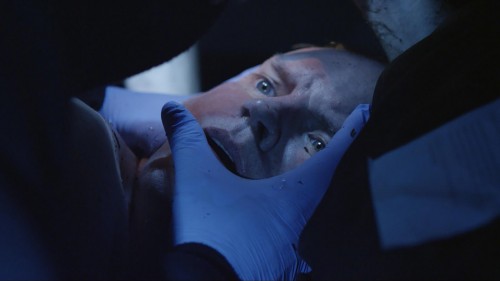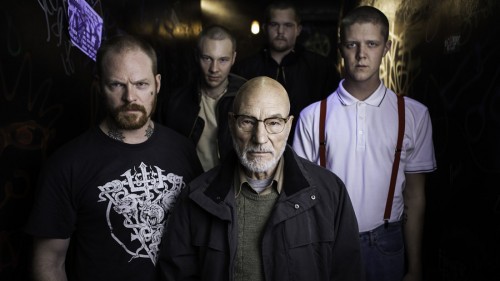Matt’s Sundance Diary: Part Two, by Matt Warren
Sundance 2016 has been the most exhausted I’ve been in the entire two decades that I’ve been going to the Festival. It’s no surprise why—I’ve been pulling quintuple duty, scrambling around town like a whirling dervish on angel dust, writing movie reviews for BP and producing videos for day job at Film Independent.
So there’s that, not to mention keeping up with an ambitious social calendar that has me going all over Park City, meeting up with local Utah friends and logging face time with colleagues visiting from out of town. Plus carving out time to help my parents move into their new house—just down the street from the Prospector Theater!
Point is, please forgive my sloppy typing and rotten brain—Sundance fever has me punchier than Blake Griffin drinking fisticuffs juice on Tornado alley.
That was a dumb sentence. You deserve better than that. Luckily the finish line is within sight and I’m determined to drag myself across it like a Warby Parker-wearing Hugh Glass. So hang in there—we’ll get through this together.
31
First things first: I’m an old school Rob Zombie fan from way fucking back. My favorite concert going memory of all time is the ersatz White Zombie frontman’s 1998 tour stop at the Great Saltair in Salt Lake during the Hellbilly Deluxe era—which involved (among other kitschy spookshow visuals) a clear Lucite guitar filled with cow blood. So never let it be said that I’m not all-in on Zombie as a purveyor of industrial pop metal mayhem served up in a big bag of Halloween candy.
But Rob Zombie as a film director? Feelings are mixed. Most people prefer its 2005 sequel The Devil’s Rejects, but my favorite Rob Zombie joint is his 2003 feature film debut, House of 1,000 Corpses—in my opinion the most unmediated expression of Zombie’s fetishistic affinity for gloriously low rent monster matinee aesthetics.
Regretably, Zombie’s new flick 31 is a step backwards following 2012’s witchy Lords of Salem, which showed the Zombie brand evolving into something subtler and more atmospheric. By contrast, 31 feels like a retreat to familiar Devil’s Rejects territory—retreading Zombie’s pre-Salem penchant for unlikeable redneck protagonists, mad torturers, and shrill sub-Kevin Smith dialogue.
The plot follows a group of traveling carnies in 1970s America who, stranded in the (I think) California desert, run afoul of a group of effete libertines led by Malcolm McDowell. McDowell and his cadre of posh snuff enthusiasts force our hillbilly heroes to compete in a savage game called “31”, which leads to an episodic series of run-ins with a volleyball team’s worth of high-concept killers, all set against the grimy industrial drip of an abandoned damp pipe factory.
It’s okay, but it definitely feels like lesser Zombie, if it’s even possible for a director of dubious merit to have a film in his- or her oeuvre that can be considered “lesser.” It wouldn’t take much for Zombie’s movies to be a whole lot better than they are. Unfortunately, the director seems stubbornly committed to staying in his lane and as such, 31 feels a bit safe and uninspired. Not what you’d hope for or expect from a dude who named himself after an ambulatory corpse.
The Blackout Experiments
In my last Sundance Diary, I talked about Penny Lane’s NUTS! and the rise of the animated documentary. Well, the sub-categorization and genre-ization of the nonfiction form continues unabated with Rich Fox’s horror doc The Blackout Experiments—the single scariest film I saw at this year’s festival.
Premiering as part of Sundance’s “Midnight” genre section, Blackout Experiments delves into the curious world of Blackout, a for-profit organization of psychological terrorists (therapists?) who provide individually customized horror haunt experiences explicitly designed to exploit—and therapeutically confront—their clients’ deepest fears and insecurities.
But what exactly does Blackout do? For most of the clients/victims interviewed in the film, Blackout goes something like this: after filling out a questionnaire about their deepest psychological phobias and neurosis participants are given a time and location to report to for indoctrination. Upon arriving participants are physically assaulted, stripped naked, verbally abused, and humiliated. For fun!
It’s pretty intense stuff to watch, despite the fact that you as the audience ostensibly know that the “victims” are—theoretically, though the line certainly gets blurry—willing participant enthusiastically paying for the privilege of being water boarded, slapped, and forcibly branded with tattoo needles.
The Blackout Experiments limits its POV to that of Blackout’s diverse roster of victim-clients, exploring with admirable humanity their motivation for subjecting themselves to such extreme entertainment. Blackout’s actual creators are glimpsed only briefly and never appear on camera to explain themselves. But it’s just as well—maintaining a foreboding sense of mystery is key to their business model.
Like Blackout itself, Fox’s doc won’t be everyone’s cup of tea. But as a portrait of extreme experiences half-understood, it’s fascinating stuff.
Green Room
Jeremy Saulnier’s neo-noir Blue Ruin is one of my favorite films of the decade, so expectations were high as I shuffled into The MARC, my favorite Sundance venue, for the director’s follow-up, Green Room. As luck would have it, I was rewarded with by far my favorite film of this year’s Sundance—a violent, fun “punks vs. Neo-Nazis” thriller that’s part Peckinpah, part John Carpenter, and 100% Maximum Rocknroll.
Green Room follows The Ain’t Rights, a hardscrabble hardcore band from Arlington, VA working the punk rock tour circuit, syphoning gas to get to the next show and sleeping four bodies deep in the back of a rickety passenger van. Taking a slot on the bill at a backwoods venue that turns out to be a Neo-Nazi clubhouse, the band unluckily catches a glimpse of a murder in the club’s titular green room.
The Ain’t Rights (including Anton Yelchin, Alia Shawkat, and Imogen Poots) are forcibly detained while the panicked skinheads (led by menacing patriarch Patrick Stewart—yes, that Patrick Stewart) try to figure out what to do with them. Then all hell breaks loose. Reminiscent of Panic Room in both its claustrophobic content and chilly emerald-tinted cinematography, Saulnier’s locked-room thriller devolves into bloodshed to become Assault on Precinct 13 by way of Alternative Tentacles.
In his review, BP’s David Bax rightly praised Room’s punk verisimilitude; during the Q&A Saulnier gave some background on his own punk past and explained how the film’s plot was partially inspired by the violence of the DC hardcore scene and the insidious invasion of far-right fascists into the community.
Green Room’s dingy Nazi-punk hideaway is expertly shot. The geography is totally clear at all times, and it helps that Salnier shoots his action with total lucidity, making sure every squib hit and baseball bat thwack! lands with the maximum impact. Green Room hits, and hits hard. Great movie—highly recommended.
Suited
Despite being a committed gorehound, three back-to-back helpings of ultraviolent genre fare left me in the mood for a change of pace. It seemed like Suited might be a good option, so I flagged down the elusive Temple Theater shuttle and made my way over to director Jason Benjamin’s documentary about transgender self-acceptance as expressed through fashion.
Unfortunately, the film—co-produced by Girls showrunners Lena Dunham and Jenni Konner—wound up being little more than an extended branded content piece for Bindle & Keep, the Brooklyn-based bespoke tailoring shop whose roster of gender-nonconforming clients star as the film’s subjects.
Founded by cisgendered tailor Daniel Friedman and his transman apprentice Rae Tutera, Bindle & Keep’s mission, at least as stated in the documentary, is to provide stylish, comfortable clothing for clients who have transitioned from one gender to another, or are in the process of transitioning—including those who’ve settled somewhere in the mushy middle of the gender spectrum.
Benjamin—who works by day as Girls’ boom mic operator—follows roughly half-a-dozen Bindle & Keep clients of every gender type. The interviewees speak movingly about their struggle toward self-acceptance, and the challenge of finding a visual presentation representative of their identity.
Trans issues have been at the media forefront a lot this past year, spotlighted by trans celebrities like Caitlyn Jenner, as by shows such as Transparent and Orange is the New Black. It’s a huge topic, with trans acceptance being the next logical step in society’s evolution toward fully understanding human gender and sexuality.
So, I’d hate for my tepid response here to be misinterpreted as a diminishment of the trans community. But there’s no getting around it—Suited isn’t much of a movie. Really, there doesn’t seem to be enough material here for a feature length film, and I couldn’t escape the feeling that what I was watching was basically just a commercial.
It’s not fun to feel like you’re being prejudiced against an entire community simply because you found one specific documentary a bit lightweight and boring, but there you go. My point is, I’m the one you should feel sorry for in this scenario :-/



























